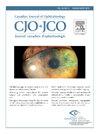假性虹膜脱落综合征患者术中虹膜松弛综合征的发生率和预测。
IF 2.8
4区 医学
Q1 OPHTHALMOLOGY
Canadian journal of ophthalmology. Journal canadien d'ophtalmologie
Pub Date : 2024-08-03
DOI:10.1016/j.jcjo.2024.06.006
引用次数: 0
摘要
目的调查假性虹膜外翻(PXF)患者术中虹膜松弛综合征(IFIS)的发生率,并分析术前眼部预测因素:设计:回顾性病例对照研究 方法:研究包括224只PXF患者眼和287只无PXF的对照眼。每位患者均有一只眼睛在 2020 年 1 月至 2021 年 12 月期间在沃尔夫森医疗中心接受了白内障手术。对患者的医疗记录进行了审查。收集的数据包括人口统计学特征、病史、术前眼科综合检查、生物测量、手术过程细节和 IFIS 发生情况。通过单变量和多变量分析,分析了 IFIS 与术前眼部参数的关系:结果:PXF 患者年龄更大,青光眼患病率更高(分别为 77.6 ± 6.4 岁 vs 74.2 ± 7.6 岁;P < 0.001;20.1% vs 9.8%,P < 0.001)。两组接受α-受体阻滞剂治疗的比例相似。PXF 组的 IFIS 率为 12.5%(28 人),而对照组为 7.3%(21 人)(P < 0.05)。如果剔除使用α-受体阻滞剂的患者,PXF 组的 IFIS 率明显更高(9.9% 对 4.8%;P < 0.05)。PXF 患者的瞳孔扩张直径明显较低(5.8 ± 1.1 mm vs 6.9 ± 0.99 mm;P < 0.001)。生物计量学评估显示,前节深度(ACD)和晶状体厚度(LT)存在明显差异。多变量分析表明,PXF 和瞳孔缩小仍是 IFIS 的重要预测因素:结论:本研究证实了 PXF 与白内障手术中 IFIS 风险增加之间存在关联,且与α-受体阻滞剂治疗无关。本文章由计算机程序翻译,如有差异,请以英文原文为准。
Prevalence and prediction of intraoperative floppy iris syndrome in patients with pseudoexfoliation syndrome
Objective
To investigate the incidence of intraoperative floppy iris syndrome (IFIS) in patients with pseudoexfoliation syndrome (PXF) and analyze preoperative ocular predicting factors.
Design
A retrospective case-control study
Methods
The study included 224 eyes with PXF and 287 control eyes without PXF. One eye per patient, who underwent cataract surgery at the Wolfson Medical Center between January 2020 to December 2021, was included. Medical records of the patients were reviewed. Data collected included demographic characteristics, medical history, preoperative comprehensive ophthalmic examination, biometry, surgical procedure details, and IFIS occurrence. The association of IFIS with preoperative ocular parameters was analyzed through both univariant and multivariant analyses.
Results
Patients with PXF were older and had a higher prevalence of glaucoma (77.6 ± 6.4 years vs 74.2±7.6 years; p < 0.001, and 20.1 % vs 9.8 %, p < 0.001, respectively). Prevalence of α-blockers treatment was similar in both groups. IFIS rate among the PXF group was 12.5% (n = 28) compared to 7.3% (n = 21) in the control group (p < 0.05). When omitting patients exposed to α-blockers, the PXF group exhibited a significantly higher IFIS rate (9.9% vs 4.8%; p < 0.05). Pupil dilation diameter was significantly lower among PXF patients (5.8 ± 1.1 mm vs 6.9 ± 0.99 mm; p < 0.001). Biometric evaluation revealed significant differences in anterior segment depth (ACD) and lens thickness (LT). Multivariate analysis indicated that PXF and decreased mydriatic pupil size remained significant predictors of IFIS.
Conclusion
This study establishes an association between PXF and an increased risk of IFIS during cataract surgery, independent of α-blockers treatment.
Objectif
Examiner l'incidence du syndrome de l'iris flasque peropératoire (SIFP) en présence d'un syndrome de pseudo-exfoliation (SPE) et analyser les facteurs de prédiction oculaires préopératoires.
Nature
Étude cas-témoins rétrospective.
Méthodes
L’étude regroupait 224 yeux présentant un SPE et 287 yeux témoins sans SPE. A été inclus un œil par patient ayant subi une chirurgie de la cataracte au Wolfson Medical Center entre janvier 2020 et décembre 2021. Les dossiers médicaux des patients ont été passés en revue. Au nombre des données recueillies, citons les caractéristiques démographiques, les antécédents médicaux, les résultats de l'examen ophtalmologique préopératoire complet et des tests biométriques de même que les données en lien avec la chirurgie et l'apparition d'un SIFP. Des analyses univariée et multivariée ont servi à examiner le lien entre le SIFP et les paramètres oculaires préopératoires.
Résultats
Les patients du groupe atteint d'un SPE étaient plus âgés (77,6 ± 6,4 ans vs 74,2 ± 7,6 ans; p < 0,001) et plus nombreux à présenter un glaucome (20,1 % vs 9,8 %; p < 0,001). L'utilisation d'alpha-bloquants était semblable dans les 2 groupes. Le taux de SIFP au sein du groupe SPE se chiffrait à 12,5 % (n = 28), comparativement à 7,3 % (n = 21) dans le groupe témoin (p < 0,05). Si l'on omet les patients qui recevaient des alpha-bloquants, le groupe SPE présentait un taux significativement plus élevé de SIFP (9,9 % vs 4,8 %; p < 0,05). Le diamètre de la pupille dilatée était significativement moindre en présence de SPE (5,8 ± 1,1 mm vs 6,9 ± 0,99 mm; p < 0,001). Les résultats des tests biométriques ont mis au jour des différences significatives quant à la profondeur du segment antérieur et à l’épaisseur du cristallin. Selon l'analyse multivariée, le SPE et une diminution de la taille de la pupille dilatée demeurent des facteurs de prédiction significatifs du SIFP.
Conclusion
Notre étude fait ressortir un lien entre le SPE et un risque accru de SIFP pendant une chirurgie de la cataracte, sans égard à la prise d'alpha-bloquants.
求助全文
通过发布文献求助,成功后即可免费获取论文全文。
去求助
来源期刊
CiteScore
3.20
自引率
4.80%
发文量
223
审稿时长
38 days
期刊介绍:
Official journal of the Canadian Ophthalmological Society.
The Canadian Journal of Ophthalmology (CJO) is the official journal of the Canadian Ophthalmological Society and is committed to timely publication of original, peer-reviewed ophthalmology and vision science articles.

 求助内容:
求助内容: 应助结果提醒方式:
应助结果提醒方式:


